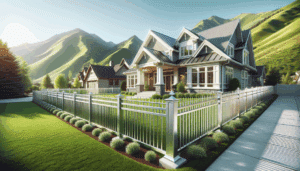In an age where sustainability is paramount, it’s essential to consider environmentally friendly options in every aspect of our lives, including our homes and properties. Fencing is no exception. At Logan Fence Company, we’re dedicated to helping you make eco-conscious choices for your fencing needs.
Contents
Wood Alternatives: Sustainable and Stylish
Bamboo Fencing
Bamboo is a rapidly renewable resource, making it an excellent eco-friendly fencing material. It’s durable, aesthetically pleasing, and can be harvested without harming the plant. Bamboo fencing adds a touch of natural beauty to your property.
Composite Fencing
Composite materials, often made from recycled wood and plastics, provide the look of wood without the environmental impact. They are durable, low-maintenance, and resistant to rot and pests.
Recycled Materials
Fencing made from recycled materials, such as reclaimed wood or plastic, reduces waste and lessens the demand for new resources. These materials can offer durability and style while minimizing environmental harm.
Metal and Steel: Longevity and Recyclability
Aluminum Fencing
Aluminum is a lightweight and corrosion-resistant metal, known for its recyclability. Choosing aluminum fencing not only ensures longevity but also contributes to the circular economy.
Steel Fencing
Steel is a strong and durable material that can last for decades. It’s also highly recyclable, making it an eco-friendly choice. Opting for steel fencing means your fence can be recycled at the end of its life.
Living Fences: The Ultimate in Sustainability
Benefits of Living Fences
Living fences, created from plants like shrubs, trees, or bamboo, provide numerous environmental benefits. They offer natural habitat for wildlife, improve air quality, and absorb carbon dioxide.
Maintenance Tips
Living fences require ongoing care, including pruning and watering. However, the environmental benefits they provide make the maintenance effort worthwhile.
DIY Eco-Friendly Fencing Projects
Upcycling Materials
Consider upcycling materials like pallets or reclaimed wood to create eco-friendly fences. These projects reduce waste and give new life to discarded materials.
Planting Hedges and Green Barriers
Planting hedges or creating green barriers with native plants not only provides privacy but also promotes biodiversity and supports local ecosystems.
Sustainability and Aesthetics: A Perfect Match
Design Considerations
Incorporate eco-friendly fencing into your property’s overall design to ensure it complements your landscape while minimizing its environmental impact.
Eco-Friendly Stains and Finishes
Use environmentally friendly stains and finishes to protect and enhance the appearance of your eco-conscious fence.
FAQs (Frequently Asked Questions)
How long do eco-friendly fences typically last?
The lifespan of eco-friendly fences varies depending on the material and maintenance. Many can last for decades with proper care.
Are eco-friendly materials more expensive?
While some eco-friendly materials may have a higher initial cost, they often provide long-term savings through durability and low maintenance.
Can I install eco-friendly fencing myself?
DIY installation is possible for many eco-friendly fencing options, but professional help may be needed for more complex projects.
Do living fences require a lot of maintenance?
Living fences, like any plantings, require regular maintenance, including pruning and watering, to ensure they thrive.
How can I make my existing fence more eco-friendly?
Consider adding plantings around your fence, using eco-friendly stains, or applying recycled materials to enhance the sustainability of your existing fence.
Embrace eco-friendly fencing options that align with your commitment to sustainability with Logan Fence Company. Visit our website at Logan Fence Company to explore our range of environmentally conscious fencing solutions.
For personalized advice and assistance, contact us at 435-383-5152 or fill out our online contact form here.




